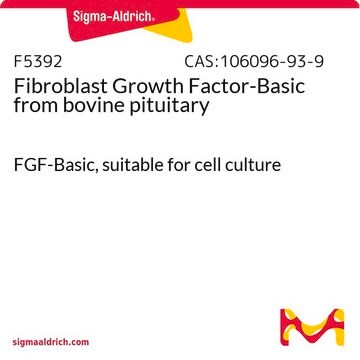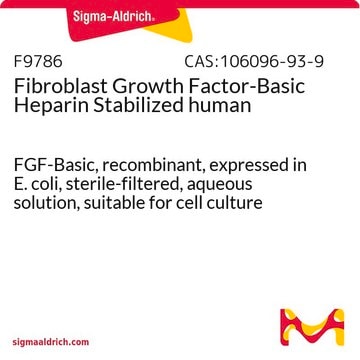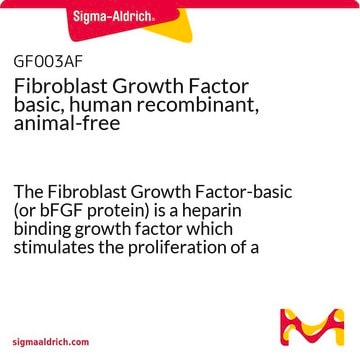Kluczowe dokumenty
F8424
Fibroblast Growth Factor-4 human
≥95% (SDS-PAGE and HPLC), recombinant, expressed in E. coli, lyophilized powder, suitable for cell culture
Synonim(y):
hFGF-4, FGF-4, K-FGF
Wybierz wielkość
2750,00 zł
Wybierz wielkość
About This Item
2750,00 zł
Polecane produkty
Nazwa produktu
Fibroblast Growth Factor-4 human, FGF-4, recombinant, expressed in E. coli, lyophilized powder, suitable for cell culture
pochodzenie biologiczne
human
Poziom jakości
rekombinowane
expressed in E. coli
Próba
≥95% (SDS-PAGE and HPLC)
Formularz
lyophilized powder
siła działania
≤10.0 ng/mL
jakość
endotoxin tested
masa cząsteczkowa
19 kDa
opakowanie
pkg of 25 and 100 μg
warunki przechowywania
avoid repeated freeze/thaw cycles
metody
cell culture | mammalian: suitable
zanieczyszczenia
<1 EU/μg
numer dostępu UniProt
temp. przechowywania
−20°C
informacje o genach
human ... FGF4(2249) , FGF4(2249)
Szukasz podobnych produktów? Odwiedź Przewodnik dotyczący porównywania produktów
Opis ogólny
Zastosowanie
Działania biochem./fizjol.
Postać fizyczna
Komentarz do analizy
Kod klasy składowania
11 - Combustible Solids
Klasa zagrożenia wodnego (WGK)
WGK 3
Temperatura zapłonu (°F)
Not applicable
Temperatura zapłonu (°C)
Not applicable
Środki ochrony indywidualnej
Eyeshields, Gloves, type N95 (US)
Wybierz jedną z najnowszych wersji:
Certyfikaty analizy (CoA)
Nie widzisz odpowiedniej wersji?
Jeśli potrzebujesz konkretnej wersji, możesz wyszukać konkretny certyfikat według numeru partii lub serii.
Masz już ten produkt?
Dokumenty związane z niedawno zakupionymi produktami zostały zamieszczone w Bibliotece dokumentów.
Produkty
Fibroblast growth factors in cell culture and various growth factors for your research
Czynniki wzrostu fibroblastów w hodowli komórkowej i różne czynniki wzrostu na potrzeby badań
Active Filters
Nasz zespół naukowców ma doświadczenie we wszystkich obszarach badań, w tym w naukach przyrodniczych, materiałoznawstwie, syntezie chemicznej, chromatografii, analityce i wielu innych dziedzinach.
Skontaktuj się z zespołem ds. pomocy technicznej








